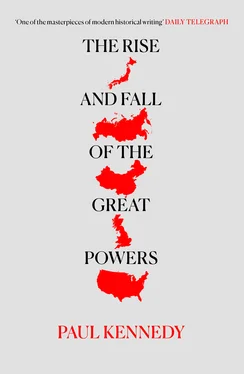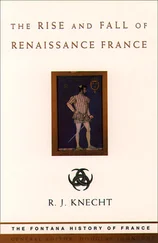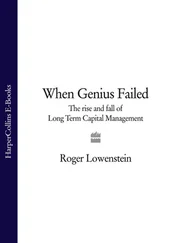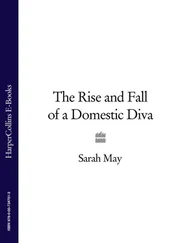Although the major development of the fifty years after 1900 can thus be seen as the coming of a bipolar world, with its consequent crisis for the ‘middle’ powers (as referred in the titles of Chapters 5 and 6), this metamorphosis of the entire system was by no means a smooth one. On the contrary, the grinding, bloody mass battles of the First World War, by placing a premium upon industrial organization and national efficiency, gave imperial Germany certain advantages over the swiftly modernizing but still backward czarist Russia. Within a few months of Germany’s victory on the eastern front, however, it found itself facing defeat in the west, while its allies were similarly collapsing in the Italian, Balkan, and Near Eastern theatres of the war. Because of the late addition of American military and especially economic aid, the western alliance finally had the resources to prevail over its rival coalition. But it had been an exhausting struggle for all the original belligerents. Austria-Hungary was gone, Russia in revolution, Germany defeated; yet France, Italy, and even Britain itself had also suffered heavily in their victory. The only exceptions were Japan, which further augmented its position in the Pacific; and, of course, the United States, which by 1918 was indisputably the strongest power in the world.
The swift post-1919 American withdrawal from foreign engagements, and the parallel Russian isolationism under the Bolshevik regime, left an international system which was more out of joint with the fundamental economic realities than perhaps at any time in the five centuries covered in this book. Britain and France, although weakened, were still at the centre of the diplomatic stage, but by the 1930s their position was being challenged by the militarized, revisionist states of Italy, Japan, and Germany – the last intent upon a much more deliberate bid for European hegemony than even in 1914. In the background, however, the United States remained by far the mightiest manufacturing nation in the world, and Stalin’s Russia was quickly transforming itself into an industrial superpower. Consequently, the dilemma for the revisionist ‘middle’ powers was that they had to expand soon if they were not to be overshadowed by the two continental giants. The dilemma for the status quo middle powers was that in fighting off the German and Japanese challenges, they would most likely weaken themselves as well. The Second World War, for all its ups and downs, essentially confirmed those apprehensions of decline. Despite spectacular early victories, the Axis nations could not in the end succeed against an imbalance of productive resources which was far greater than that of the 1914–18 war. What they did achieve was the eclipse of France and the irretrievable weakening of Britain – before they themselves were overwhelmed by superior force. By 1943, the bipolar world forecast decades earlier had finally arrived, and the military balance had once again caught up with the global distribution of economic resources.
The last two chapters of this book examine the years in which a bipolar world did indeed seem to exist, economically, militarily, and ideologically – and was reflected at the political level by the many crises of the Cold War. The position of the United States and the USSR as powers in a class of their own also appeared to be reinforced by the arrival of nuclear weapons and long-distance delivery systems, which suggested that the strategic as well as the diplomatic landscape was now entirely different from that of 1900, let alone 1800.
And yet the process of rise and fall among the Great Powers – of differentials in growth rates and technological change, leading to shifts in the global economic balances, which in turn gradually impinge upon the political and military balances – had not ceased. Militarily, the United States and the USSR stayed in the forefront as the 1960s gave way to the 1970s and 1980s. Indeed, because they both interpreted international problems in bipolar, and often Manichean, terms, their rivalry has driven them into an ever-escalating arms race which no other powers feel capable of matching. Over the same few decades, however, the global productive balances have been altering faster than ever before. The Third World’s share of total manufacturing output and GNP, depressed to an all-time low in the decade after 1945, has steadily expanded since that time. Europe has recovered from its wartime batterings and, in the form of the European Economic Community, has become the world’s largest trading unit. The People’s Republic of China is leaping forward at an impressive rate. Japan’s postwar economic growth has been so phenomenal that, according to some measures, it recently overtook Russia in total GNP. By contrast, both the American and Russian growth rates have become more sluggish, and their shares of global production and wealth have shrunk dramatically since the 1960s. Leaving aside all the smaller nations, therefore, it is plain that there already exists a multi polar world once more, if one measures the economic indices alone. Given the book’s concern with the interaction between strategy and economics, it seemed appropriate to offer a final (if necessarily speculative) chapter to explore the present disjuncture between the military balances and the productive balances among the Great Powers; and to point to the problems and opportunities facing today’s five large politico-economic ‘power centres’ – China, Japan, the EEC, the Soviet Union and the United States itself – as they grapple with the age-old task of relating national means to national ends. The history of the rise and fall of the Great Powers has in no way come to a full stop.
Since the scope of this book is so large, it is clear that it will be read by different people for different purposes. Some readers will find here what they had hoped for: a broad and yet reasonably detailed survey of Great Power politics over the past five centuries, of the way in which the relative position of each of the leading states has been affected by economic and technological change, and of the constant interaction between strategy and economics, both in periods of peace and in the tests of war. By definition, it does not deal with small powers, nor (usually) with small, bilateral wars. By definition also, the book is heavily Eurocentric, especially in its middle chapters. But that is only natural with such a topic.
To other readers, perhaps especially those political scientists who are now so interested in drawing general rules about ‘world systems’ or the recurrent pattern of wars, this study may offer less than what they desire. To avoid misunderstanding, it ought to be made clear at this point that the book is not dealing with, for example, the theory that major (or ‘systemic’) wars can be related to Kondratieff cycles of economic upturn and downturn. In addition, it is not centrally concerned with general theories about the causes of war, and whether they are likely to be brought about by ‘rising’ or ‘falling’ Great Powers. It is also not a book about theories of empire, and about how imperial control is effected (as is dealt with in Michael Doyle’s recent book Empires ), or whether empires contribute to national strength. Finally, it does not propose any general theory about which sorts of society and social/governmental organizations are the most efficient in extracting resources in time of war.
On the other hand, there obviously is a wealth of material in this book for those scholars who wish to make such generalizations (and one of the reasons why there is such an extensive array of notes is to indicate more detailed sources for those readers interested in, say, the financing of wars). But the problem which historians – as opposed to political scientists – have in grappling with general theories is that the evidence of the past is almost always too varied to allow for ‘hard’ scientific conclusions. Thus, while it is true that some wars (e.g. 1939) can be linked to decision-makers’ fears about shifts taking place in the overall power balances, that would not be so useful in explaining the struggles which began in 1776 (American Revolutionary War) or 1792 (French Revolutionary) or 1854 (Crimean War). In the same way, while one could point to Austria-Hungary in 1914 as a good example of a ‘falling’ Great Power helping to trigger off a major war, that still leaves the theorist to deal with the equally critical roles played then by those ‘rising’ Great Powers Germany and Russia. Similarly, any general theory about whether empires pay, or whether imperial control is affected by a measurable ‘power–distance’ ratio, is likely – from the conflicting evidence available – to produce the banal answer sometimes yes, sometimes no.
Читать дальше












